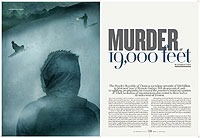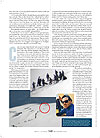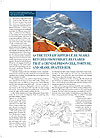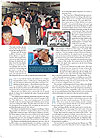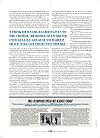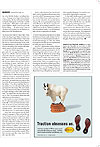» home » portfolio » reportage
Murder at 19,000 Feet
The People’s Republic of China is spending upwards of $60 billion to host next year’s Olympic Games. But no amount of cash or “Up With People” sloganeering can conceal the country’s brutal occupation of Tibet, as several mountaineers discovered to their horror 19 miles west of Everest.
The first gunshot went largely unnoticed by the climbers. Most were still in their tents — the sun had risen, but it hadn’t been up long enough to blunt the knifing cold — and no one expected to hear small-arms fire on a mountaineering expedition, much less at 19,000 feet in the Himalayas. Later, though, a few climbers would recall that the ravens that hung around camp had suddenly lifted from the snow in a small, black, squawking cloud, a missed omen.
Earlier that morning, on September 30, 2006, the first clear day in a week, the Sherpas in camp had conducted a ritual for the safety of the climbers. There were about 100 or so huddled at Cho Oyu Advanced Base Camp; most had not yet made their attempts on the summit because of the poor weather. The world’s sixth-tallest mountain, Cho Oyu is the second most popular Himalayan peak for climbers, and it’s often used as a test run for those who aspire to climb the most popular one, Mount Everest, 19 miles to the east. As part of their safety prayer the Sherpas had uttered incantations beneath fluttering Tibetan Buddhist prayer flags and burned juniper, which left a resinous aroma around the 70 or so brightly colored domes.
Among those the Sherpas blessed was Luis Benitez, a 33-year-old commercial guide from Colorado who was getting his three clients ready for the four-day summit push. When the first rifle shot was fired, his crew were in their tents packing, sorting, and repacking, and could have easily mistaken the gun’s report for a snapping tent flap.
A few minutes later, near 8 am, Benitez’s team had gathered at the camp cook tent for tea. Moments later one of Benitez’s Sherpas burst in: “Chinese soldiers coming, very bad!” This time they all heard the distinctive, percussive cracks from type 81 assault rifles, the Chinese answer for AK-47s.
Benitez and the others dropped their mugs and ran outside. They were shocked to find as many as TK Chinese soldiers belonging to the People’s Armed Police, or PAP, a mountain paramilitary unit, lined up on a shelf of ice over the glacial moraine 200 yards away; others, hefting matte black rifles, marched toward the camp. Still other soldiers, in small clusters, perhaps three or four in each, were farther down slope, about 150 yards. They were doing most of the firing. As they popped off rounds, the smell of cordite had replaced juniper in the air.
At first Benitez and the others thought the gunmen must be shooting at animals — but what? Then, to their horror, they realized, no, the soldiers were taking aim at two snaking lines of 20 to 30 people moving up a glaciated slope, at least one wounded and yards away. Against the aching white expanse of snow the figures were tiny black silhouettes, and tiny, but even at a distance of a couple hundred yards, the climbers could make out that many of the figures were smaller still — children — and stumbling as the bullets thudded around them. At that range, the type 81s — street fighting weapons, not sniper rifles — are woefully inaccurate, so the gunmen were essentially taking potshots.
Benitez heard cries of anguish drifting across the glaciated pass, punctuated by the crack-popping of the Chinese Kalashnikovs, which made his ears ring. Taking a grave risk, Romanian climber Sergiu Matei, 29, took out his Canon 350 video camera. “They are shooting them like dogs,” he uttered. Then, abruptly, what looked to be three figures dropped to the snow. Two struggled up and staggered on. One figure tried to crawl, but then collapsed in an immobile heap.
C ho oyu, elevation 26,906 feet, lies just north of Nepal in Tibet. Sherpas know it as the Green Goddess, while the Lamas, the second largest ethnic group in Nepal, believe that Buddhism’s only saint, Padma Sambhava, buried instructions on how to save the earth from chaos somewhere on the mountain. At the height of the climbing season, in autumn, the slopes of Cho Oyu are as cosmopolitan as an olympiad, as climbers from around the world make for the top of the sacred massif, the easiest of the earth’s 14 peaks that rise above 8,000 meters (or 26,250 feet). Last September, Advanced Base Camp had alpine athletes from the U.K., France, Australia, New Zealand, Romania, Slovenia, Russia, and the U.S., among others.
Along with foreign mountaineers and guides like Luis Benitez, Cho Oyu is an international crossroads because of the Nangpa La Pass, not far from where Advanced Base Camp is established most years. Because it is remote, hard terrain, Nangpa La Pass is a difficult part of the border for the Chinese to patrol, and thus it’s here that Tibetans looking to leave their occupied homeland undetected risk the elements for freedom abroad. In 1955, the Dalai Lama used this very route to escape into exile; Xinhua, the government-run Chinese news network, has dubbed it a “golden route” for Tibetans seeking asylum from Chinese rule.
It’s also a trade route; some of the traders using the Nangpa La Pass had stopped in camp to sell their wares, including knockoff name-brand parkas from Beijing. But the people the Chinese were shooting at now didn’t look like traders, and they weren’t. Many were nuns and monks, unable to practice their faith legally in Tibet, where Tibetan Buddhists, according to Chinese law, are criminals. While a few Tibetans can travel abroad with permission, fleeing refugees violate Article 322, get jailed immediately, and, according to Human Rights Watch, are often tortured.
As the shooting erupted around him that morning, Benitez says, he contemplated a “Rambo action” to try to disrupt the Chinese soldiers. Only Benitez is no commando; he’s a happy-go-lucky mountain guide and party animal whose most notable achievement at the time was helping blind climber Erik Weihenmayer gain the summit of Everest in 2001. To his self-confessed shame, Benitez stood openmouthed, his hands at his sides, as the PAP used the Tibetans for target practice.
On the one hand, this most recent Himalayan disaster had a familiar ring to it, as the mountaineers had to choose between their own selfish goals and helping others in distress. Several of the climbers, including Benitez, continued up toward the summit after the Chinese soldiers stormed their camp, rounding up the refugees.
But in most other respects this incident stood alone: a cold-blooded murder by the host nation’s own police left foreign witnesses not knowing at all what to do, or what was expected of them. Confusing matters further, a handful of commercial outfitters and their guides allegedly told climbers not to tell anyone outside of camp about the shooting. Fearful the Chinese authorities would revoke their permits to operate on Cho Oyu and the Chinese/Tibetan side of Everest, or that they’d seek revenge on the Tibetan cooks and porters in their employ, two of the top Everest guide operations allegedly supressed news of the incident.
The incident made headlines, especially in Europe, when it reached news media in October of last year, but drawing upon more than 30 interviews, previously confidential transcripts, and a journey to Cho Oyu and India, this is the first complete account of the events. Before the climbers spoke out, and Sergiu Matei aired his video, the Chinese claimed the shootings had been in self-defense, while climbers the world over were left to contemplate what it said about their sport that their peers would put their personal and commercial goals ahead of reporting an atrocity. Truly, the whole episode could play as farce if it hadn’t cost at least one young woman her life, and if it hadn’t exposed, on the eve of the Beijing Olympics, the brutal contempt the Chinese authorities continue to have for Tibetans.
Like many of the estimated 2,500 to 3,500 Tibetans who flee their occupied homeland each year, Kelsang Namtso wanted the freedom to practice Tibetan Buddhism. (Even displaying a Tibetan flag on an interior wall can result in years of jail time.) A serious young woman who dressed in the traditional long skirts of a Tibetan nomad, Kelsang, 17, and her best friend Dolma, 16, rosy-cheeked and more jovial than her friend, left Nagchu, their home in a rural area northeast of Tibet’s capital, Lhasa, with the intention of seeking the Dalai Lama, their leader in exile, in Dharamsala, India.
Kelsang and her five older brothers grew up with parents who struggled to make ends meet as semi-nomads, Dolma told me. Forced to recite paeans to Mao Tse Tung, Kelsang dreamed of becoming a nun. (In Tibet it’s an honor for one child from every family to follow a Buddhist calling; it accrues “merit” for the whole family.) But Kelsang’s parents were against it. Her mother had arthritis and felt that her only daughter should be at home helping her. “Her mother didn’t want her to be a nun because she was the only girl,” says Dolma. “She said she had to help her mother.”
Undaunted, Kelsang took vows with Lamas in secret, stopped listening to music and dancing, which she loved, and maintained a strict vegetarian diet. Eventually, she left under the cover of night for a free life, on September 18, 2006.
After dodging Chinese army patrols in Lhasa, Kelsang and Dolma were crammed into the back of a truck with 75 other refugees numbering monks, nuns and children as young as five. Dolma, Kelsang, and the others had paid around $500 each — two years of wages for rural Tibetans — to two men, illegal guides, who were irascibly stowing everyone in the truck. Even before they left, one man’s courage deserted him. He jumped off the truck and fled home. As they lurched on into the night, another started vomiting with fear.
As the vehicle rumbled out of Lhasa, sliding past Chinese checkpoints, the mood inside was desperate. Inside the juddering, dark, and airless interior, children began to cry, cries that risked everyone by alerting Chinese border guards. The guides urged them to be silent with hoarse whispers. Guides face the death penalty for leading refugees out of Tibet.
Terrified, the guides pushed hard, getting angry when anyone faltered. Temperatures dropped to well below freezing. Dolma and Kelsang walked with the hems of their skirts sodden and caked with snow, their arms folded across their chests to keep their fingers warm as they stumbled and fell. They had left with a store of tsampa, roasted barley, to sustain them, but their supply ran out; worse, they found themselves without water. Some tried to eat snow. In the end they came across shepherds, who charged them 70 yuan for plastic bags of water.
Kelsang, with Dolma at her side, was faring badly. The altitude and lack of food gave her splitting headaches. Finally, 12 days after leaving Lhasa, a monk in the group spotted orange and yellow climbers’ tents, incongruous against the dazzling white. “I used to see tents in a book when I was in Tibet, but since I am from a rural area, I hadn’t seen them like that before,” the monk told me. “I thought they were all from USA because when I was in Tibet, if I saw one Westerner I thought they must come from the USA.” Some in the group hurried on ahead to beg food from the climbers.
Figures clad in long coats clambered down the rocks toward them. The monk thought they were other Tibetan monks in religious dress and waved. The refugees turned to one another and embraced as relief swept through the group. Then someone realized the long coats were actually fur-lined Chinese army–issue, known as dayi. The smiles froze on the refugees’ faces. Some in the group shouted warnings, “They are soldiers!” and urged everyone to run.
Pandemonium erupted. One soldier started screaming, “Thama de!” which loosely translates as “Fuck your mother.” Puffs of snow erupted around them as bullets tore into the ice.
“I heard the bullets zinging past my ears,” says Dolma. “The noise was like, tag, tag. And then when they came past my ears, they were like, pew, pew. We tried to run, but in the thin air you would have to be Superman to be able to do that.”
Refugees split off in different directions. A few escaped. Somewhere in the melee Dolma lost Kelsang. Her back to the soldiers and woozy from the altitude, Kelsang presented a slow-moving target. She was a few yards from cresting a southern ridge and getting out of range when a 7.622mm round tore into her back, just under her right arm. She slumped in the snow and, 20 minutes from freedom, died.
Back in camp sergiu matei, the romanian climber, switched off his camera. “I didn’t want to film her dying,” he said. He had 22 minutes of film that would have a devastating worldwide impact — if he could get it out of the country. Immediately Matei felt a lingering gaze from a soldier nearby. He waved to the soldier and swallowed hard, trying not to betray his fear as he walked back to his tent to stow the tape. Minutes later the Chinese police marched the first of several groups of refugees they’d captured into camp. One included Kelsang’s friend Dolma. Another included about a dozen kids.
“The children were in single file, about six feet away from me,” Steve Lawes, a British climber, later told Washington, DC–based International Campaign for Tibet. “They didn’t see us. They weren’t looking around the way kids normally would. They were too frightened. By that time Advanced Base Camp was crawling with soldiers. They had pretty much taken over, and the atmosphere was very intimidating. We were doing our best not to do anything that might spark off more violence.”
The soldiers marched the kids into a big green tent flying a Chinese flag, a tent that was off-limits to the foreign climbers. Soon after, a PAP soldier entered the camp with an injured Tibetan on his back. The Tibetan appeared to have been shot in the leg, but the soldier dumped him on the snow like a sack of grain. In all, at least 30 refugees were brought to the green tent, then herded off to Tashi Dzong military base, tk miles away. There, according to testimony given to the International Campaign for Tibet, several were severely beaten.
The climbers were appalled, but felt helpless to intervene. A few of the PAP soldiers were actually friendly to the climbers; in their late teens, they took breaks in camp, lit cigarettes, and carried on as if everything that had just happened was routine, a morning’s work.
Four hours later a Nepali kitchen boy came running to Matei: Someone was hiding in the toilet tent, he said. Matei went to investigate. Hunkered in the latrine, his hands shaking, was a man called Choedron, a poor farmer in his 30s who had left his children behind to try to escape to India. He had tried to bury himself in rocks, pathetically using a toilet paper bag to cover himself. As the tent zip ripped up, he nearly retched from fright; he feared that a Chinese prison cell, torture, and shame awaited him. Instead, he was confronted with Matei, whose goatee, earrings, and loose locks lend him the look of a death metal bassist. Unable to speak Tibetan, Matei said the first thing that came to mind: “Dalai Lama.” Choedron put his hands together in veneration. They understood each other.
Matei acted quickly. First he tried to convince the base camp manager to help the terrified refugee. He refused. “The Chinese will shoot us if we are caught,” he said. “It is much too dangerous.” Over the manager’s protests, Matei took Choedron from the tent and fed him. Starving after three weeks in the snow, he devoured any food set in front of him. Afterward Matei gave him all of this spare clothes and then hid him in his personal tent. As darkness fell Matei wanted to videotape Kelsang’s body as evidence of the murder. Again, he faced the wrath of the base camp manager. “It’s too dangerous; you’ll be shot,” he told Matei. This time Matei, reluctantly, took his advice.
By 2:30 am Choedron was ready to leave. The stress of hiding Choedron, along with the tape he had of the shootings, had turned Matei into a nervous wreck. With the pass below them, glistening in the moonlight, they looked at each other awkwardly. Matei clapped Choedron on his back, and said, in Romanian, “God be with you.” Out in the night a group of refugees was hiding in a snow hole, waiting for their turn to run under the protective cloak of darkness. A few crept to Kelsang’s body. One nun crouched by her side, lifted her arm, and saw congealed blood, now frozen.
The next day a small detachment of Chinese soldiers and officials returned to Kelsang’s body. There they posed for pictures, with the body in the foreground and Cho Oyu in the background, like hunters with a prize buck. They covered the corpse of the 17-year-old nun-to-be in a red blanket and hurled it into a crevasse.
Amid doubts that he should be doing more to help the captive Tibetans, Benitez had reflexively returned to his clients and their summit preparations. “My first responsibility is to my team,” he recalls thinking. Besides, focusing on what he knew helped calm his nerves. It was a decision, he says today, that “I’ll regret the rest of my life.”
Matei, watching as Benitez and other teams carried on to the summit, was disgusted. “No one was saying, This is bad,” he says. “Everyone was just like, Where’s my coffee? Let’s have some tea and get ready.”
Benitez didn’t make the summit. Nor did his clients, who succumbed to altitude sickness. One turned back on the first day, returning with one of Benitez’s Sherpas. The other client made it a second day, but then asked Benitez to take him down.
“On that climb I’ve never had such heavy feet,” Benitez says. “The summit push is meant to be where all your hard work pays off; it was the final fight of the mountain, but at that point none of us wanted to go to the top. Our hearts weren’t in it. We were fighting to reach the top, but we felt that we were fighting for the wrong thing. All we had were questions about what we had seen. We had no fight in us.”
When Benitez returned to camp he was surprised to learn no one had reported the shooting to anyone outside the camp. “I really thought all the climbers would be standing up for human rights,” he says.
Instead, climbers were being urged by at least two outfitters not to e-mail anyone what they had seen. Renowned Slovenian climber Pavle Kozjek, who witnessed the shooting, said, “For most people in the base camp the most important thing was to be able to come back again. This was the strongest factor in their behavior. They decided not to tell what had happened because of this.” And, he said, “I heard many expedition leaders forced their clients not to report these events.”
But Benitez couldn’t live with himself. He sent an e-mail to Explorers Web, an expedition website, at 7 am on October 2. The header of the e-mail read: “Story not being told here in Tibet.” He detailed the shooting, asked for his name to be kept out of it, and ended by saying, “We need to tell the world about this little corner of the planet, where people are dying attempting to reach a better life.”
A few hours later Kate Saunders, from the International Campaign for Tibet, alerted governments worldwide and took the issue up with China. “Over those few days I was trying to speak to as many climbers up there as possible,” she says. “Luis was the only climber who would speak to us from Cho Oyu, inside Tibet.”
Meanwhile, as Benitez was ordering yaks and packing for the trail down, he confided to his assistant guide, Paul Rogers, that he’d sent the note. Immediately afterward, Benitez claims, Rogers “did a Judas.” (Rogers declined to comment.)
Rogers went straight to Russell Brice, CEO of Himalayan Experience, the biggest commercial climbing operator on Everest. Brice, hero of Discovery Channel’s Everest: Beyond the Limit, dropped the sage, avuncular manner of his television persona and became enraged. Brice works closely with the Chinese, depending upon them for climbing permits to run his business; he pulls in, by some estimates, $10 million a year. “And that’s a low estimate,” says Tom Sjorgen, who runs Explorers Web with his wife Tina and is a known critic of Brice. “Any business in the Himalayas somehow has Russell Brice involved in it.”
Brice, with Rogers at his side, stormed down the hill at around 3 pm. “Paul told me you sent an e-mail to Explorers Web,” Brice accused Benitez. “Are you trying to get us kicked out of the country?” He began jabbing his finger at the younger guide. “Are you fucking crazy?” “This ‘free Tibet’ thing is bullshit,” Rogers jumped in. “The Chinese have done more for Tibet than you know. These people they shot at were human traffickers. It’s a girl-smuggling ring to Mumbai. The only reason you want to tell everyone is that you want to be famous.”
Benitez was shocked. During his whole career he had, in his own words, “deeply respected” Brice, and had often sought his advice. And if Benitez were out for fame, as Rogers claimed, he was going about it the wrong way, requesting that ExWeb keep his name out of it.
Then Brice stunned Benitez further. Not only had Brice tried to keep the killing a secret; he and his team had treated the Chinese soldiers who killed Kelsang for snow blindness shortly after the shooting. Now Benitez went on the offensive: “So basically, you have been treating the murderers?”
Benitez retreated to his tent, but 45 minutes later Brice and Rogers returned with a third man, climbing operator Henry Todd.
“You should be fucking hung out to dry for what you have done,” Todd yelled at Benitez. Todd, a.k.a. the Toddfather, is a large, ruby-faced man known for his vicious temper; he’s an ex-con, having served seven years in jail for possession of LSD as part of a massive drug sting in Britain in the late 1970s. In 2000 Todd violently assaulted one of his own clients, an American reporter named Finn-Olaf Jones, who felt so threatened by the incident he took a helicopter out of camp a few days later. Nepalese authorities banned Todd from Nepal for two years. In TK, he changed the name of his company from Himalayan Guides to Ice 8000, and is now back in operation with the help of the Chinese. Having been cast out by the Nepalis, Todd didn’t want to get banned by the Chinese, too.
“I think your name has been given to the Chinese,” Todd hissed, trying to intimidate Benitez. “If I were you I would leave ahead of your group, or you will get them into trouble.” Eventually the three left, but from that moment on, Benitez says, he was afraid for his own personal safety. (Neither Brice nor Todd responded to repeated requests for comment.)
Benitez and his clients made it down to Kathmandu. Border guards didn’t detain any of them, but Benitez was indeed a wanted man. Word was out that the Chinese embassy wanted to talk to him, along with two other British climbers, including Steve Lawes. Hoping to leave Nepal without any further confrontations, Benitez holed up in the Radisson hotel in Kathmandu. On October 7, doubts assailing him — “What if these people really were people traffickers? Maybe I ruined my career for nothing” — his phone rang. Unsure of who knew he had checked in to the Radisson, he didn’t know if he should answer.
The romanian who’d taken the video of the shootings, Sergiu Matei, faced his own anxious journey to safety. He knew that he had incontrovertible proof that Chinese riflemen had shot an unarmed teenager in the back.He stashed the tape of the shooting in his pants pocket, and burned a hole in the casing of the cassette with a cigarette to make it look like garbage.
At the New Delhi airport a man with a gun under his coat approached Matei, saying he was with the Austrian embassy. He asked him what his occupation was and which mountain he’d been on in Nepal. “I’m a dentist,” Matei lied. “I was on Annapurna.” It seemed to satisfy the man, whoever he was, as he left. “I was shitting my pants,” said Matei. “On the mountain, if they had caught me with that tape, I thought I would be shot on the spot, and the Chinese would have said a Romanian had died in an avalanche. I hate communism.
I’ve lived with it too long.” On October 10, 2006, the Chinese released a statement through the news agency Xinhua claiming that soldiers had found “stowaways” and tried to “persuade them to go home. But the stowaways refused and attacked the soldiers.” The report added: “Under the circumstances the frontier soldiers were forced to defend themselves and injured two stowaways.” And concluded: “One injured person later died in hospital due to oxygen shortage on the 6,200-meter land.”
On October 13, Matei’s footage aired on Pro TV Romania, and was quickly screened by the BBC, CNN, and other networks worldwide. (It can now be seen on YouTube.). Diplomats from around the world condemned the Chinese forces — none more forcefully than Clark Rand, the U.S. ambassador in Beijing.
Away from the news cameras, says ICT, many of the captured refugees were beaten with rubber hoses and electric cattle prods. Police interrogated the children, and insinuated that they had been sent to India to be “trained” by the Dalai Lama and then sent back to China as terrorists. The youngest children were not collected by their parents and so remained in custody for three months. When their parents came they were fined 100 to 500 yuan ($12–$60), according to the International Campaign for Tibet.
Dolma, who witnessed the death of her best friend, made it to freedom in Dharamsala, India, where the Tibetan government is in exile. She met the Dalai Lama, and is now in the process of becoming a Buddhist nun. She gazed out at the mountains as she sat in a green park with the Himalayas in the background. She clasped her hands under her thighs and rocked back and forth as tears rolled down her cheeks. “Kelsang would have been pleased that I made it,” she told me. Kelsang’s body was never found or returned to her family.
After several rings, benitez snatched the telephone from its cradle in his room at the Kathmandu Radisson. Instead of a Chinese agent, it was Kate Saunders, from the International Campaign for Tibet. She offered to assuage his fears that he’d been misinformed by taking him to meet 43 Tibetans.
In an SUV with smoked windows, Benitez and Saunders drove along Kathmandu’s bustling backstreets to the Tibetan Refugee Reception Center, on the eastern edge of the city. There Benitez saw monks sitting in prayer in loose groups alongside families with children in cheap, tattered Chinese sneakers. He looked at snapshots covering an entire wall of the dusty clinic. Many were painful to look at, as many Tibetans suffered horrific frostbite, their toes and fingers blackened, as they made it over the Nangpa La Pass. Any doubts he had had that he’d interfered with policing human traffickers dissipated. He wept for a moment, before regaining his composure.
In May 2007, Benitez made it to the top of Everest for a sixth time, and he did it from China’s Tibet, without any hassle from the authorities. Normally wasted but ecstatic atop the roof of the world, Benitez says that this time he experienced a curious sense of disappointment.
“I realized I’m not a fireman or a policeman or anyone else who saves lives,” he says. “I’m just a mountaineer, part of a substrata of society that people can’t peg. What happened on Cho Oyu made me realize that there is something more important than just reaching the summit. So I stood there, on top of Everest, and thought, What’s the point of this?”
* Names and locations have been changed in this article to protect sources from Chinese Government retribution.

